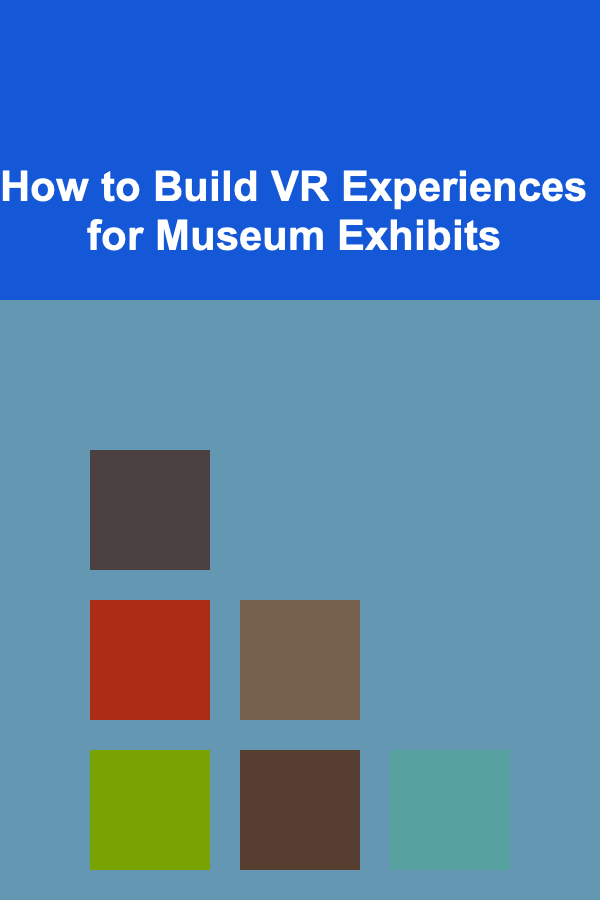
How to Build VR Experiences for Museum Exhibits
ebook include PDF & Audio bundle (Micro Guide)
$12.99$10.99
Limited Time Offer! Order within the next:

In recent years, Virtual Reality (VR) has emerged as a transformative tool across various sectors, and museums are no exception. The potential of VR to immerse users in interactive, 3D environments allows for an enhanced understanding of history, culture, and art. By integrating VR into museum exhibits, institutions can engage visitors in innovative ways, enriching the educational experience and offering an entirely new perspective on collections.
This article provides a comprehensive guide on how to build VR experiences for museum exhibits. We will explore the necessary tools and technologies, the process of designing and developing the VR experience, best practices for content creation, and the challenges to consider when implementing VR in museums.
The Potential of VR in Museums
Before diving into the technical aspects, it is essential to understand why VR is becoming a significant component of museum experiences. Traditional exhibits often present artifacts or works of art that can be appreciated visually, but VR offers a dynamic, immersive, and interactive experience that can engage multiple senses. By allowing visitors to explore environments that are otherwise inaccessible or difficult to recreate, VR opens new possibilities for storytelling and learning.
Key Benefits of VR in Museums
- Immersive Learning: VR provides an opportunity for visitors to "step into" different historical periods, explore ancient cities, or interact with works of art in ways that are not possible with traditional exhibits.
- Enhanced Accessibility: For visitors who may not be able to physically visit certain locations, VR can simulate environments or experiences that may otherwise be off-limits.
- Interactive Experiences: VR enables visitors to interact with exhibits, allowing for a more personalized and engaging experience.
- Multisensory Engagement: VR has the ability to stimulate multiple senses, including sight, sound, and touch, creating a deeper emotional connection with the content.
- Scalability and Flexibility: VR allows museums to expand their reach by offering virtual tours that can be accessed remotely, thereby attracting a global audience.
Examples of VR in Museums
Several institutions have already embraced VR to create exceptional exhibits. For instance, the British Museum has developed VR experiences that allow users to explore the ancient city of Babylon, while the Smithsonian Institution has used VR to provide virtual tours of their collections, such as the Apollo 11 landing.
These examples highlight the incredible potential of VR to transform the museum experience, creating opportunities for education, engagement, and preservation that were previously unattainable.
Key Considerations for Building VR Experiences
When developing VR experiences for museum exhibits, there are several important considerations to keep in mind. These considerations influence the design, development, and deployment of the VR project, ensuring that it meets the needs of both the museum and its visitors.
1. Understanding the Audience
Before beginning the development process, it is crucial to understand the target audience. Different visitors have varying preferences, prior knowledge, and levels of technological comfort. Understanding these factors will help tailor the VR experience to the audience's expectations.
For example:
- Children may benefit from gamified experiences, interactive storytelling, and vibrant visuals.
- Scholars and researchers may be interested in detailed, accurate representations of historical artifacts or events.
- General visitors may prefer a more narrative-driven experience with easy navigation and intuitive interactions.
2. Content Creation
The content of the VR experience is the heart of the project. This step involves gathering the materials and information needed to bring the exhibit to life. Museum curators, historians, and subject matter experts should collaborate to ensure that the content is accurate, engaging, and meaningful. The content must also be presented in a way that takes full advantage of the VR medium.
Some key aspects of content creation include:
- 3D Modeling and Animation: Museums may have access to high-quality 3D scans of artifacts or historical sites. These models can be used to create accurate representations of objects or environments in VR.
- Storytelling: The narrative in a VR experience should be compelling, interactive, and immersive. Whether it's exploring an ancient ruin or witnessing a historical event, the story should keep the visitor engaged.
- Audio: Sound design plays an important role in VR experiences. Using spatial audio, where sounds change based on the visitor's location or orientation, can greatly enhance immersion.
3. Technology Selection
Choosing the right technology is essential to creating a high-quality VR experience. There are many tools and platforms available for VR development, each with its own advantages and limitations.
Hardware
- VR Headsets : The VR headset is the primary device for delivering the experience. Popular choices include the Oculus Quest , HTC Vive , and PlayStation VR. Each offers different levels of performance, with standalone devices like the Quest offering portability, while systems like the HTC Vive provide higher fidelity.
- Motion Controllers: Motion controllers allow users to interact with the VR environment. For interactive exhibits, these controllers enable visitors to manipulate objects, navigate virtual spaces, or trigger events within the experience.
Software
- Unity: One of the most widely used game engines for VR development, Unity offers a range of tools and resources for building interactive 3D experiences. It is compatible with various VR platforms and is well-suited for creating both simple and complex museum exhibits.
- Unreal Engine: Known for its high-fidelity graphics, Unreal Engine is another powerful tool for creating immersive VR environments. It's often preferred for projects that require photorealistic visuals.
- Blender: Blender is a free, open-source tool that can be used to create 3D models and animations for VR. It's an excellent choice for museums with limited budgets.
Platforms for Distribution
- VR Caves and Immersive Rooms: Many museums are installing VR Caves---large immersive rooms equipped with multiple projectors and screens to create a more interactive experience.
- Mobile VR: For portability and ease of access, mobile VR platforms like Oculus Quest or smartphones with VR headsets can allow visitors to engage with exhibits in a more flexible way.
4. User Experience (UX) Design
In VR, the user experience is critical. The design should ensure that the visitor feels comfortable navigating the environment, interacting with objects, and understanding the flow of the experience. Poor UX can lead to disorientation, frustration, or even motion sickness, which could negatively impact the visitor's enjoyment.
Key UX Considerations:
- Intuitive Navigation: The virtual environment should be easy to navigate. Whether using a controller, gesture-based input, or eye-tracking, the navigation must feel natural.
- Comfort: Ensuring that the VR experience is physically comfortable is essential. Avoid excessive movement or uncomfortable headgear that could cause discomfort.
- Interaction Design: Interactions should be simple and responsive. For example, if a visitor selects an artifact, the system should offer clear feedback, such as a zoomed-in view or an audio explanation.
- Story Flow: The pacing and progression of the experience should feel cohesive, with the story naturally leading the visitor from one section to another without confusion or delays.
5. Integration with Existing Museum Infrastructure
VR experiences should seamlessly integrate with the existing museum infrastructure. This includes ensuring that VR stations are set up in accessible areas with adequate space for visitors to engage with the experience. For larger-scale installations, the museum may need to modify its layout to accommodate VR setups.
Some integration strategies include:
- Creating VR Stations: Designated areas equipped with VR headsets, controllers, and safety measures.
- Incorporating VR into Guided Tours: VR can complement guided tours by providing immersive, on-demand experiences, such as showing ancient ruins in their original form.
- Hybrid Experiences: Combine traditional exhibits with VR for a hybrid experience. For instance, visitors could view artifacts in a museum gallery and then use VR to explore a detailed 3D recreation of the artifact's historical context.
6. Testing and Feedback
Once the VR experience is developed, testing is crucial. This phase involves both technical testing (e.g., ensuring compatibility across devices) and user testing (e.g., gathering feedback from real visitors).
User testing is especially important for VR, as different people will have different reactions to the technology. It's important to:
- Ensure that the system is easy to use and intuitive.
- Test for motion sickness, discomfort, or disorientation.
- Collect feedback from visitors to understand what works and what can be improved.
7. Deployment and Maintenance
After testing and refinement, the VR experience is ready for deployment. However, the work doesn't end there. Museums need to regularly update and maintain the VR content to ensure it remains relevant and functional. This includes addressing software updates, improving the content, and keeping up with new technological advancements.
Challenges in Implementing VR in Museums
While the potential of VR in museums is undeniable, several challenges come with integrating this technology into exhibits.
1. Cost: Developing high-quality VR experiences can be expensive, particularly for smaller museums with limited budgets. The cost of hardware, software, and content creation may pose a significant barrier.
2. Technology Accessibility: Not all visitors are familiar with VR, and some may feel intimidated by the technology. Providing adequate training and support is essential to making the experience accessible.
3. Maintenance and Support: VR equipment requires ongoing maintenance to ensure that it functions correctly. This can involve troubleshooting hardware, updating software, and providing staff with training on how to assist visitors.
4. Space Requirements: VR installations can require considerable physical space to accommodate users and equipment, which can be difficult to manage within the limited space of a museum.
Conclusion
Building VR experiences for museum exhibits offers a unique opportunity to redefine the way we interact with art, history, and culture. By using immersive technology, museums can transport visitors to different times and places, create more engaging educational opportunities, and offer new forms of interaction with collections. However, creating these experiences requires careful consideration of content, technology, user experience, and logistical constraints.
By combining creativity with technical expertise, museums can leverage VR to craft unforgettable experiences that inform, inspire, and engage audiences in unprecedented ways. As VR technology continues to evolve, the future of museum exhibits promises to be even more dynamic, interactive, and immersive.

How to Build a Loyal Clientele for Your Nail or Eyelash Services
Read More
How to Light Your Home for the Holidays with Budget-Friendly Ideas
Read More
How to Optimize Your Cooking Time During Meal Prep
Read More
How to Sell Used Photography Equipment on OfferUp: A Step-by-Step Guide
Read More
How to Utilize Vertical Space in Small Apartments
Read More
Crafting Exquisite Non-Alcoholic Coffee Beverages
Read MoreOther Products

How to Build a Loyal Clientele for Your Nail or Eyelash Services
Read More
How to Light Your Home for the Holidays with Budget-Friendly Ideas
Read More
How to Optimize Your Cooking Time During Meal Prep
Read More
How to Sell Used Photography Equipment on OfferUp: A Step-by-Step Guide
Read More
How to Utilize Vertical Space in Small Apartments
Read More